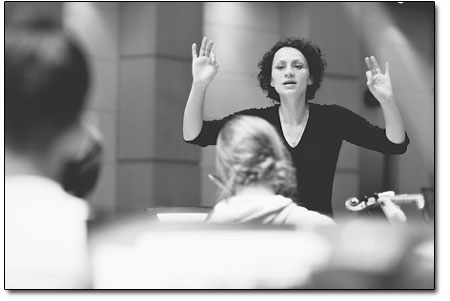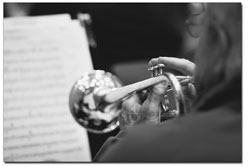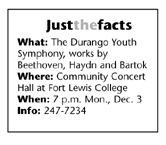| ||||||
Speaking Beethoven
by Judith Reynolds Da-DAH, da-DAH, Da-da-da-da-DAH.” Kasia Sokol speaks out a Beethovian rhythm and asks the 40-odd members of the Durango Youth Symphony to repeat it. “Put down your instruments and say this three times – together. Make it crisp.” The first time around, it’s a muddle. A cluster of blurry syllables emerge from a group of young people in jeans, sweatshirts and knit caps huddled together on the stage of the Community Concert Hall at Fort Lewis College. This is the final rehearsal for the winter concert, which happens next Mon., Dec. 3. “Again,” Sokol urges her musicians. They range in age from pre-teen to 60, topped by Gary Ruggera, M.D., a retired anesthesiologist who has magically transformed himself into a full-time music major at Fort Lewis College. “Kasia asked me to join the orchestra,” Ruggera said during a rehearsal break last Monday night. “I’m a jazz studies major, but I love this. I started trumpet in 1974, and here I am playing Beethoven in the Concert Hall.” The so-called dress rehearsal felt a bit ragged; they usually do. It’s part of the folklore of the performing arts. In light of that, Sokol focused on rhythmic precision for the Beethoven, having the students speak more than play complex passages. “Now, each time you repeat that figure,” Sokol cajoled them, “add a crescendo – very soft to very loud. Again. Three times. Stop. Again, and stay together!” The musicians quickly got into the spirit of the rehearsal. They tossed off phrases from section to section and finally gave Sokol the punch she wanted on accented notes. The orchestra seemed to be “getting” Beethoven by speaking Beethoven.
When Katarzyna Maria Sokol rehearses the Durango Youth Symphony it’s all about rhythm, precision, energy … and passion. Sokol is the new conductor of the orchestra, launching its second chapter. A visiting instructor at Fort Lewis College, she’s taken over the baton of founding director, Mikylah Myers McTeer who has moved on to a position at West Virginia University. A native of Poland, Sokol, 30, is known as Kasia (a nickname for Catherine). She came to the United States in 1994 to study violin at the prestigious Interlochen Arts Academy in Michigan. Since then, she’s completed a high school degree, her bachelor’s in violin performance at Western Michigan University and a master’s in violin and orchestral studies from Northwestern University. While in Chicago, she played for two years in the Chicago Civic Orchestra and various chamber groups. Now Sokol is in the final stages of a doctorate at Indiana University. After she completes oral examinations Feb. 4, her terminal degree in violin performance with a minor in string pedagogy and music history will be in hand. “I love teaching,” Sokol said in an office interview at Fort Lewis College last week. In the FLC Music Department, she coaches seven violin students, teaches two classes – Music Fundamentals and the Experience of Music – directs the Durango Youth Symphony, and is concertmaster of the San Juan Symphony. Sokol is also the new member of the Red Shoe Piano Trio, Durango’s one true, ongoing chamber music ensemble. “This is a wonderful department,” Sokol said of her faculty colleagues, “We all feel passionate about teaching. My colleagues care about their students – their growth as musicians and as human beings.” On Aug. 15, when Sokol arrived in Colorado, the most daunting task, she said, was to reconstitute the Durango Youth Symphony and prepare a concert in three months. “My criteria? First I had to see what was in the music library, then what instruments would be represented,” she said. “In the auditions, I learned that I would have two high school flute players, one clarinet player from Fort Lewis, and one FLC horn player. I knew I would have to ask a few more players to join us. The Beethoven (two movements from Symphony no. 1, Op.21) has more parts than we have players or instruments. So we made the decision, if necessary, for all the parts to be played by other instruments. For example, the bassoon solos will be played by the French horn. The oboe solos will be played by the flutes.” Did anyone say daunting? The other big work on the program is Bela Bartok’s Rumanian Folk Dances, all seven of them, and all full of energy and dynamism. The work calls for fewer instruments outside of the string sections, but still needs piccolo, clarinet and horn. “This is an educational process,” Sokol said about the whole rehearsal period. “Everyone is learning an instrument and learning the music. I tell a lot of stories, for example, about the stormy character of Beethoven, about losing his hearing after he wrote the first symphony – the one we are playing. The score is so clear, and the texture is not too thick to hear every phrase, every rhythmic figure. It’s a wonderful musical experience for all of us to play this program.” In addition to the two big symphonic works, two chamber ensembles will play Haydn trios. Pianist Jack Maynes and cellist Melanie Ellison will appear in both trios, and the orchestra’s two flutists will each play in one – Kari Bjorlin and Megan Deaver. And if the orchestra strays from its much practiced Beethovian rhythms, Sokol threatened to start clapping and/or stomping the tempo to get them back together. How’s that for a conductor’s challenge? •
|
In this week's issue...
- May 15, 2025
- End of the trail
Despite tariff pause, Colorado bike company can’t hang on through supply chain chaos
- May 8, 2025
- Shared pain
Dismal trend highlights need to cut usage in Upper Basin, too
- April 24, 2025
- A tale of two bills
Nuclear gets all the hype, but optimizing infrastructure will have bigger impact




